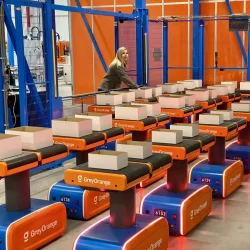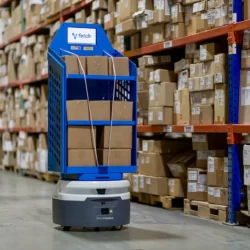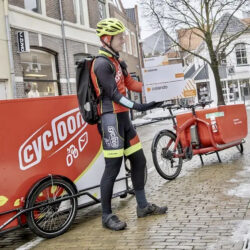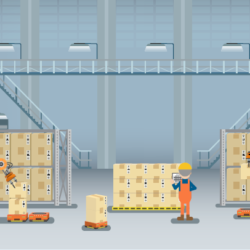Autonomous mobile robots can make fulfilment cheaper, faster and better

Online turnover has risen sharply in recent years and many retailers are now faced with having to make major investments in their supply chains. They need to increase their fulfilment capacity and set up local micro-fulfilment centres to deliver to consumers faster. The deployment of autonomous mobile robots can help, said GreyOrange during a recent Webinar Wednesday – not only on a large scale in the central distribution centre, but also on a small scale in the shop’s stockroom.
By Marcel te Lindert
When Europe went into lockdown in the spring of 2020, web shops saw sales grow twice as fast as normal. This led to an unexpectedly high workload in the fulfilment centres, which were already struggling to recruit good staff. The pressure is further increasing due to the rising demand for fast delivery; 36% of consumers abort their online purchases if they see that they will have to wait ‘too long’ – i.e. longer than a day – for their parcel. “What’s more, consumers expect retailers to take care of the delivery costs,” said Sarah Gardner, Vice President of Product Marketing at GreyOrange.
And those delivery costs can be sizable. Gardner presented the results of a study showing that retailers have to pay 20% more for next-day delivery. The cost for home delivery can amount to as much as 20% of the value of the goods. In comparison, next-day delivery to shops costs 5 to 7% of the value. All the facts and figures illustrate the growing pressure on fulfilment centres, which have to get more done in less time and at lower costs. “Automation offers a solution. Just look at Amazon, the driving force in e-commerce. The reason why Amazon is so big has a lot to do with its use of robots,” stated Gardner.
South American DIY retailer
During Webinar Wednesday, GreyOrange presented various practical examples to demonstrate that automation pays off, including the case of Sodimac Homecenter, a DIY retail chain originally founded in Chile which currently has 250 large stores in South America. Thanks to its use of autonomous mobile robots (AMRs), the retailer now supplies its stores and also consumers from a single distribution centre. “The retailer saw its online turnover grow rapidly and the profit margin decrease. The standard solution would have been to expand the supply chain by adding a separate distribution centre for the online channel. But we were able to avoid that by automating the operation in the existing distribution centre,” said Varundev Solanki, Solutions Consultant at GreyOrange.
Sodimac currently uses AMRs for the internal transport from goods received to bulk storage, and from bulk storage to the order picking area. “As a result, they are now much less dependent on forklift truck drivers – who are also in short supply in South America – plus the operation is much safer,” continued Solanki. The order picking area consists of three floors, and AMRs are also deployed there to take the picking stock to the picking stations. “Previously, they had separate stocks for store replenishment and online orders. Now, they use the same stock and the same order picking process for all channels. So when COVID-19 hit in South America, they were able to absorb the shift to the online channel easily.”
Returns handling
Autonomous mobile robots can be used for other purposes too, such as returns handling. A European fashion retailer saw that its rapidly growing online turnover was accompanied by a significant increase in the number of returns. “The robots take care of transporting the returned products to the right workstations,” Solanki explained. “This enables the retailer to turn the operators at these workstations into specialists who are experienced at handling certain garments or certain brands. Sometimes an item such as a blouse has to be ironed or repaired before it can be put back into stock.”
This new returns process has increased the number of returned products that can be put back into stock. Moreover, those products are available for resale sooner, so there is less chance of them becoming obsolete. “An additional advantage is that the returns process now runs according to the first in, first out (FIFO) principle; the consumers get their money back in the order that the returns are received, which contributes to customer satisfaction. FIFO doesn’t apply in most returns processes.”
Micro-fulfilment centre
Retailers can often no longer deliver to consumers fast enough nowadays using large centralized distribution centres alone, which is why more and more of them are creating stock points close to major urban centres – not only at their own stores, but also as ‘dark stores’ and micro-fulfilment centres. AMRs can play an important role here too, said Solanki, who gave the example of a retailer who decided to convert one of its stores into a micro-fulfilment centre. AMRs are now in operation there which can put away goods on the shelves independently. “The store was located in an expensive location, so the retailer wanted to make optimal use of the floor space and the height of the building – and has succeeded by deploying the robots.”
A micro-fulfilment centre is ideal for use in combination with a locker system which allows consumers to collect their orders when it suits them. “The problem with lockers is that there is only a limited number of them, and if a consumer doesn’t pick up their parcel then that locker remains occupied for a long time. But in a micro-fulfilment centre, the goods can be left on the shelves until the consumer arrives to collect them, and then a robot takes the groceries to the distribution point on a just-in-time basis.”
Replenishing the shelves
The feasibility of AMRs in stores was demonstrated by a case from a European DIY chain which has deployed 50 robots in the stockroom of one of its stores. As a result, it is now able to handle more than 5,000 order lines per day for goods that will be dispatched from the store or will be collected from the store. But as far as GreyOrange is concerned, these robots could also be used to replenish the shelves in the store itself. “We have applied this principle at Sodimac in South America. The replenishment orders are picked in the distribution centre with the shelf plan in mind. When the roll cages containing those products arrive, they can immediately be taken to the right aisle in the store.”
GreyOrange emphasized that deploying autonomous mobile robots is easier than many retailers think, without the long implementation times associated with static automation systems. “Start step by step,” advised Solanki. “Select an area where you face challenges. Start there with a few robots, initially without connecting them to the warehouse management system (WMS). Experience the advantages for yourself, and then take the next step.”









